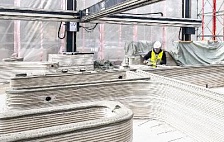CEMEX announced today that in cooperation with Synhelion they developed a groundbreaking technology designed to fully decarbonize the cement manufacturing process based on solar energy. This advancement is an important element of CEMEX’s current Climate Action strategy. Synhelion, based in Switzerland, is a global pioneer in the field of sustainable solar fuels and process heat.
The radically new approach is based on replacing the use of fossil fuels in cement plants with high-temperature solar heat, and capturing 100 percent of the carbon emissions, which are then utilized as feedstock for fuel production, enabling cement manufacturing to achieve net-zero level. This is made possible by the unprecedented temperature levels of solar heat provided by Synhelion’s technology and its pioneering process to turn CO2 into synthetic drop-in fuels, such as kerosene, diesel, and gasoline.

Render of a solar cement plant.
This solution is the very first to offer a comprehensive approach to decarbonize the cement industry. Following the research collaboration completed in spring 2020, CEMEX and Synhelion plan to adopt a staged approach towards implementing the technology. A pilot installation is expected to be incorporated into an existing CEMEX cement plant by the end of 2022 and gradually extended to a fully solar-driven plant.
“Our solar receiver demonstrably provides process heat at unparalleled temperatures beyond 1’500°C, and offers a clean alternative to burning fossil fuels,” said Gianluca Ambrosetti, CEO of Synhelion. “The CO2 emissions from the cement manufacturing mix with the heat transfer fluid for our solar receiver and are integrated into the process. As we are working in a closed-loop system, the CO2 emissions can be easily extracted. We then close the carbon cycle by using CO2 to produce fuels.”

Synhelion's 250 KW solar receiver glows after testing because it reached over 1'500°C.
“We are witnessing a completely novel way to manage the emissions from cement production by using solar heat in an advanced and sophisticated manner,” said Davide Zampini, CEMEX Head of Global R&D and IP Management. “The partnership with Synhelion reinforces our determination to decarbonize cement production and is the outcome of our persistent R&D efforts to develop sustainable solutions as well as identify strategic partners at the forefront of innovation. Synhelion shares our commitment to closing the carbon cycle and our collaboration should enable CEMEX to accelerate the pace towards achieving its net-zero CO2 ambition for 2050.”
CEMEX is a global building materials company that provides high-quality products and reliable services. CEMEX has a rich history of improving the well-being of those it serves through innovative building solutions, efficiency advancements, and efforts to promote a sustainable future.







